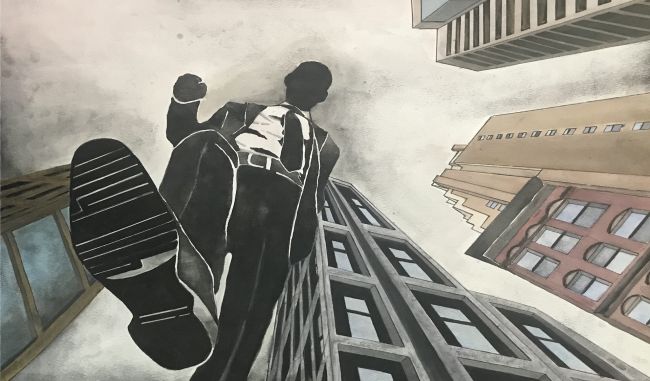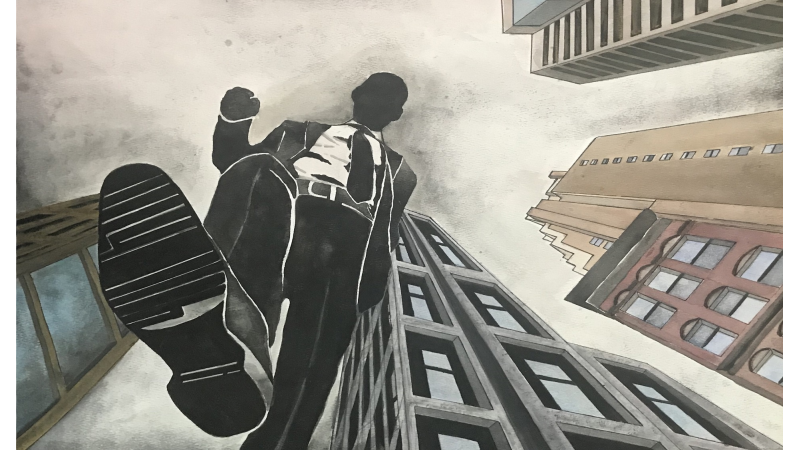This year, more than 1,700 students received national recognition in the Scholastic Art & Writing Awards, the nation’s longest running scholarship and awards program for creative teens. Among them, 16 high school seniors received the program’s highest honor: the Gold Medal Portfolio, which includes a $10,000 scholarship. Each week, we’ll highlight two of these students, one artist and one writer, to learn a little more about them, their craft, and their award-winning portfolios.
This week, we’d like to introduce you to Maximo ‘Max’ Guerra from Miami, FL and Caroline Dinh from Rockville, MD. Max’s nationally recognized art portfolio, Satirical Stereotypes, is a series of satirical architectural designs that concentrate on the theme of space. Caroline’s nationally recognized writing portfolio, electric [dreams], is a collection of pieces that uses themes of science and technology to demonstrate how coding is art, programming is poetry, and science and storytelling can be one in the same.
What was the inspiration behind your award-winning portfolio?
Max: My portfolio explores the relationship and stereotypes between people and places throughout different architectural spaces. I showcase images of various sceneries, such as a wide range of houses and public spaces. Additionally, my portfolio is inspired by various architectural styles and vantage points that help dictate which stereotype will be placed in each space.
Caroline: The main inspiration behind my portfolio was that I wanted to “invade” the hard sciences with things that aren’t supposed to be there, like infest a computer program with poetry or make space for femininity in a field dominated by men. Science fiction and software engineering were pioneered by women, after all.
Do you have a favorite piece from your portfolio? If so, which one is it, and why is it your favorite?
Max: My favorite piece would be "How The Rich See The Poor." The work consists of a silhouette of a rich businessman stepping on the viewer. The viewer is meant to take on the identity of someone poor, by showing how small they seem to someone who is more 'powerful' than them. The main reason why this is my favorite work is because it utilizes an extreme use of perspective that in turn makes the viewer feel powerless.
Caroline: My favorite piece is “DEPLOY”—I personally learned a lot about my writing style, particularly with speculative fiction, after a year of drafting and restarting this piece. I love dreaming up new worlds and concepts and bringing “what-ifs” to an extreme.

You were able to read, or see, a piece of work from another Gold Medal recipient’s portfolio. Which piece was it and what was your impression?
Max: Caroline Dinh is one of my fellow Gold Medal recipients and I got to read one of her pieces. I enjoyed her story, “DEPLOY,” which was jammed backed with imagery throughout each line. One of my favorite lines is: “T-minus eight seconds. T-minus seven. At t-minus six seconds, a history lesson flashed through her mind.” The repetitive use of 'T-minus' within that sentence depicts a sense of urgency, a countdown that ultimately furthers the plot and keeps the reader interested. I truly loved reading her work.
Caroline: I saw the watercolor and ink piece “How The Rich See The Poor,” by Maximo Guerra and was immediately blown away by the perspective work and the details of the suit outlined via negative spaces. This piece captures such a suffocating sense of helplessness—having a faceless man’s heel over your face; being stepped on; being nothing. I really, really appreciate this piece.

If you could have dinner with one notable artist or writer, living or dead, who would it be and why?
Max: To have dinner with writer Don Miguel Ruiz, would be a dream come true. Don Miguel Ruiz is a writer fascinated with the idea of dreams and how they determine the effect they place on society. Ruiz once said, “What is right and what is wrong in society, is how people see society.” Those words helped me create the idea of my art portfolio, which revolves around how people perceive one another in different settings.
Caroline: I’d love to speak with Anna Wiener about her transition from the publishing world to the Tech world and back again. I always enjoy hearing the perspectives of artists and humanities-people navigating the tech industry and how these two communities intersect or clash.
What’s next for you? What are your plans for the future?
Max: I plan to pursue architecture in college, where I plan on getting an architectural internship and eventually obtaining an architectural license. After college, I hope to own my own architectural firm.
Caroline: I just committed to the University of Maryland with a major in Immersive Media Design, a collaboration between the computer science and art departments. It makes me think a lot about the idea of being a designer—rather than just an artist or coder or creator—and I think I quite like that idea.
Image: "How The Rich See The Poor," Maximo Guerra/Alliance for Young Artists & Writers; Writing: "DEPLOY," Caroline Dinh/Alliance for Young Artists & Writers



